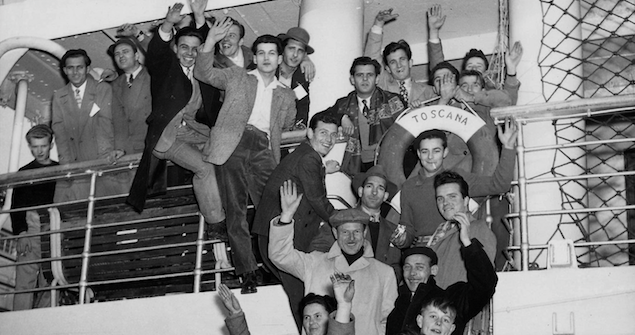Italy and Australia - Just History Now?

The Italian-Australian bilateral relationship began and ended on the basis of migration.
Prior to the agreement between Australia and Italy in 1951 related to immigration arrangements for Italians migrating to Australia, relations between these two countries were somewhat minimal and framed within very different boundaries based on past association. While a small number of Italians wound up in Australia, from the landings of Captain Cook through to the Eureka Stockade with Raffaele Carboni, this presence was always eclectic and accidental. There was little in the way of relations between these two countries and people which could be said to be significant.
Italy was a late arrival to nation statehood and Australia’s early steps of nationhood were couched in protective and cooperative colonial plans. Australia’s involvement in the key events of foreign and security policy (World War I and the difficult dialogue of the 1930s until World War II) was crafted and directed by its former colonial master, the UK. Interestingly, while Australia established an External Affairs Department in 1901, it remained inside the Prime Minister’s Department until 1934. Until 1940 Australia had no officials permanently stationed overseas other than London. There was no perceived need for a separate Australian approach given the unison between UK and Australian foreign policy interests. The one highlight of the relationship (and a negative one in hindsight) was that Italy’s participation in the Axis Alliance pitted these two countries against each other until the overthrow of Mussolini in July 1943 and the subsequent switching of sides to join the Allied powers in September of 1943. Its repercussions in a specific Australian context saw the internment of thousands of Italians, ultimately revealing some “underbelly” attitudes of the future integration of Italians in the decade that followed. This state of affairs changed somewhat after World War II and took a very different direction from 1951.
The post-war period in Australia started on the reflection that Australia was a vulnerable country. It lacked population for its own security. Moreover it also lacked unskilled labour. As a result, Australia embarked on an ambitious immigration program pioneered by the then Immigration Minister Arthur Calwell, which would provide a larger population, meet growing infrastructure requirements and allow for post-war reconstruction for increasing manufacturing investment. As a result of the immigration intake from Italy the number of Italian-born residents in Australia grew from 33,632 in 1947 to 289,476 in 1971. This was in effect the beginning and the end of Italian immigration to Australia. But was it the end of the relationship?
Looking back in 2015 the bilateral relationship between these countries never progressed from its immigration arrangements. After the end of migration from Italy (and other European locations), the relationship returned to its traditional regional view by both parties. Since the 1970s both nations have refocused their foreign allegiances on the basis of closer and regional allies and strategies. As each nation sought to pursue its national interests, this activity drew the two countries away from each other in strategic terms. Australia assumed a stronger middle power stance in the Asia-Pacific area, trying to walk a middle ground between the US and China. Despite the distancing from the paper “Australia in the Asian Century”, Australia makes no secret of its “economic diplomacy” being focused on Asian partners and especially China. On the other hand Italy furthered its interests in promoting the European Union and seeking greater levels of integration within it. Italy struggled with its ongoing economic difficulties and sought to play a leading role within the European Union.
In late 2013 the outgoing Ambassador to Italy, David Ritchie defined the Australian-Italian relationship as “non-existent”. This assertion was based on an array of measurements – no prime ministerial visits between the two, few high level government exchanges, few common projects and a general absence of interaction between the two nations. Ambassadors are rarely so frank unless they are very sure about what they are saying. But the legacy of the Italian migration period has left an indelible mark on Australian society with hundreds of thousands of people of Italian descent actively integrated in Australian society. Some of these pursue an interest in keeping the connections with Italy alive. But this was a relationship which began and ended on the basis of this migration relationship which is now a distant moment in history. Little else came into the equation. Once the raison d’être was no longer, the two countries assumed and carried on bilateral relations like that of many others, in the background, of relative interest and not of a strategic nature.
Bruno Mascitelli is an Associate Professor in European Studies at Swinburne University. This piece is adapted from an article published in the Australian Journal of International Affairs. This article can be republished with attribution under a Creative Commons Licence.





